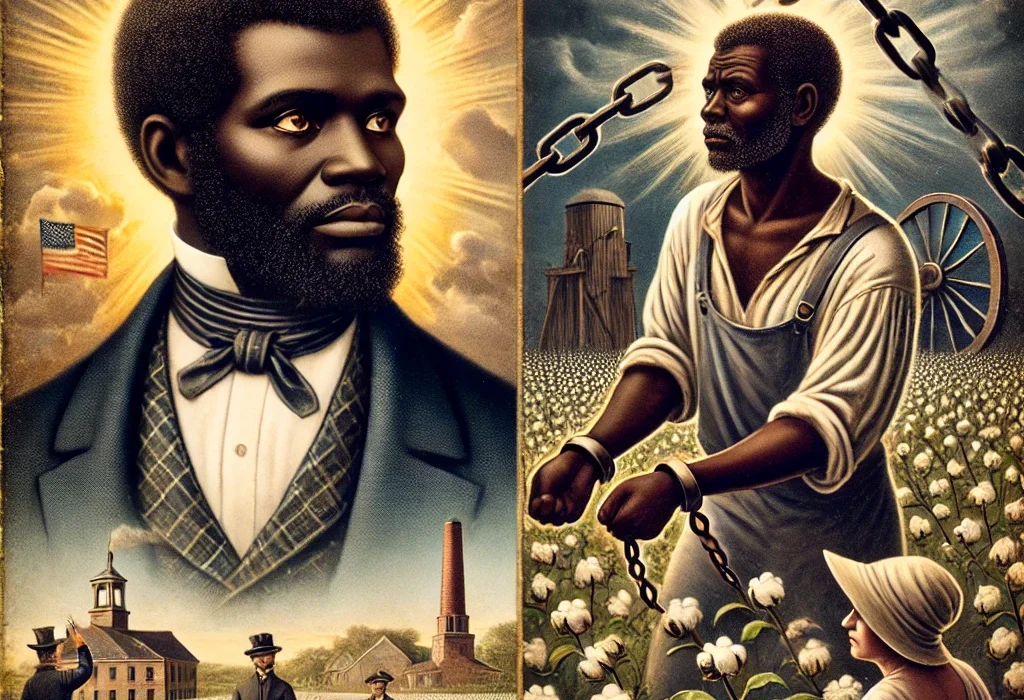Solomon Northup’s Twelve Years a Slave, published in 1853, is a harrowing autobiographical account of his abduction and forced enslavement in the American South. Born a free man in New York, Northup was kidnapped and sold into slavery in 1841, enduring twelve years of brutal servitude before regaining his freedom. The book serves as a personal narrative of survival and as a powerful condemnation of slavery’s cruelty.
Plot Summary
One bright spring morning in 1841, Solomon Northup, a free African American man, walks the streets of Saratoga Springs, New York. A husband and father, Solomon enjoys a peaceful life, earning a living as a skilled violinist and farmer. With a wife and three children at home, he has no reason to suspect the storm that is about to engulf his life. When two men, Brown and Hamilton, approach him with the offer of a well-paying job as a violinist in Washington, D.C., Solomon sees an opportunity to earn extra income for his family. The offer seems simple enough, and he agrees to accompany them.
However, after a celebratory night in Washington, Solomon wakes to find himself in chains. Dazed and disoriented, he is confined in a dark, fetid cell. The two men who had promised him work are nowhere to be found. Instead, Solomon is accused of being a runaway slave from Georgia. His protests fall on deaf ears. Stripped of his identity, his free papers stolen, Solomon realizes he has been kidnapped. With brutal efficiency, he is shackled, sold, and shipped south.
Solomon’s journey into the heart of slavery begins on a steamboat bound for New Orleans. The stifling hold of the ship is filled with others like him—human beings robbed of their freedom, sold as property. Upon arrival, Solomon is given a new name: Platt. His life as a free man is erased, and his new existence as a slave begins. He is sold to William Ford, a relatively kind man by comparison to others Solomon will encounter. Ford runs a small plantation in Louisiana, and though he owns slaves, he treats Solomon with a degree of respect, recognizing his intelligence and skills.
Yet, despite Ford’s decency, the institution of slavery is an unforgiving master. Financial pressures force Ford to sell Solomon to John Tibeats, a cruel and violent carpenter. Tibeats treats Solomon with open contempt, and their relationship quickly becomes hostile. In one terrifying incident, Tibeats attempts to lynch Solomon, leaving him dangling from a tree. Only Ford’s intervention spares Solomon from death. However, the respite is temporary. Solomon is constantly reminded that his life is worth no more than his ability to work, and any misstep could lead to deadly consequences.
After a series of transfers, Solomon eventually finds himself in the hands of Edwin Epps, a plantation owner whose cruelty knows no bounds. Epps takes perverse pleasure in beating his slaves, especially Patsey, a young woman who, despite her hard work, endures the brunt of his violent temper. Patsey, whose beauty and strength catch Epps’s obsessive attention, becomes a victim of both his sexual advances and his wife’s jealousy. She is beaten savagely, with no one to protect her. Solomon can only watch, powerless to intervene, as Patsey’s spirit is crushed under the weight of her suffering.
The harsh conditions on Epps’s plantation are unrelenting. Day after day, Solomon toils in the cotton fields under the scorching Louisiana sun, his body worn from the lashes of the whip. The cruelty he witnesses—Patsey’s abuse, the inhumane treatment of fellow slaves—wears on him, but his spirit remains unbroken. Solomon holds onto the hope of freedom, though with each passing year, the weight of despair grows heavier.
Throughout his twelve years of enslavement, Solomon never gives up his attempts to escape or communicate with the outside world. His intellect and resilience become his most valuable tools in his quest for freedom. He befriends Samuel Bass, a Canadian carpenter working on the Epps plantation. Bass, an outspoken critic of slavery, is shocked to learn of Solomon’s true identity. With Bass’s help, Solomon finally manages to get a letter to his friends and family in New York, detailing his plight and pleading for help.
The wheels of justice move slowly, but they do move. Solomon’s letter reaches Henry Northup, a family friend and lawyer who immediately begins working on his case. Months later, Henry arrives in Louisiana with papers proving Solomon’s free status. Accompanied by local officials, he confronts Epps and demands Solomon’s release. Though Epps is enraged at losing one of his most valuable slaves, he has no legal grounds to keep Solomon any longer.
After twelve long years of brutal servitude, Solomon is finally free. The moment is bittersweet, for while he regains his freedom, he leaves behind Patsey and the others who remain in bondage. The weight of their suffering stays with him as he travels north to reunite with his family. The joy of returning home is tempered by the knowledge of the countless souls still enduring the horrors of slavery. Solomon returns to his wife and children in New York, but he is forever changed, haunted by the memories of those lost years and the people he left behind.
Though free once more, Solomon’s ordeal leaves an indelible mark on his soul. His return to liberty is not just a personal triumph but a testament to the resilience of the human spirit in the face of unimaginable cruelty. The chains that bound him may have been broken, but the scars of slavery remain.
Main Characters
Solomon Northup – The protagonist and author, born a free African American in New York. Solomon is a skilled violinist and farmer. His life takes a tragic turn when he is kidnapped and sold into slavery. His resilience, intelligence, and determination to regain freedom drive the narrative.
Edwin Epps – One of Northup’s cruelest masters, a plantation owner with a violent temperament. Epps embodies the brutality of slavery, especially in his treatment of Northup and other enslaved people. His obsession with a female slave, Patsey, further highlights the inhumane treatment of slaves.
Patsey – A fellow slave on the Epps plantation, Patsey is a tragic figure. She endures extreme physical and emotional abuse from Epps while being admired for her strength and capability. Her suffering exemplifies the dehumanizing treatment of enslaved women.
William Ford – Northup’s first owner, depicted as a relatively kind and humane man, especially in comparison to others. Despite being a slave owner, Ford is portrayed as religious and more morally conflicted than the cruel overseers Northup later encounters.
Tibeats – A carpenter and an overseer, Tibeats is another cruel figure in Northup’s life. He treats Northup harshly and their contentious relationship leads to multiple violent confrontations, displaying the constant threat of violence that slaves faced.
Theme
Freedom vs. Slavery – The central theme of Twelve Years a Slave is the contrast between freedom and enslavement. Northup’s previous life as a free man and his years in bondage underscore the stark differences in human dignity, autonomy, and rights. His longing for freedom is palpable throughout the narrative.
Resilience and Survival – Northup’s determination to survive despite the cruelty he faces is a testament to human endurance. His intelligence and hope for liberation help him endure the physical and psychological torment of slavery.
Injustice and Cruelty – The systemic cruelty of slavery is a recurrent theme. Through Northup’s experiences, the reader is exposed to the horrors of physical violence, psychological manipulation, and dehumanization that were common in the system of slavery.
Racial Injustice – The book illustrates the extreme racial injustices in antebellum America. Northup’s kidnapping and subsequent enslavement reveal how African Americans, even those born free, were vulnerable to exploitation and violence under the lawless slave system.
Writing Style and Tone
Solomon Northup’s writing is both descriptive and powerful, blending factual precision with vivid storytelling. His straightforward narrative style enhances the authenticity of the harrowing events he recounts. Northup often pauses to reflect on the events of his life, and his observations on human nature and justice provide a thought-provoking commentary on the evils of slavery.
The tone throughout the memoir is somber yet resolute. Northup never embellishes his suffering but describes the cruelty and brutality he faced with clear-eyed candor. At the same time, there is a sense of dignity and quiet defiance in his writing. The tone shifts when discussing moments of kindness or hope, but it remains grounded in the grim reality of slavery. His writing powerfully conveys both the physical and emotional pain of being torn from his family and stripped of his rights.
We hope this summary has sparked your interest and would appreciate you following Celsius 233 on social media:
There’s a treasure trove of other fascinating book summaries waiting for you. Check out our collection of stories that inspire, thrill, and provoke thought, just like this one by checking out the Book Shelf or the Library
Remember, while our summaries capture the essence, they can never replace the full experience of reading the book. If this summary intrigued you, consider diving into the complete story – buy the book and immerse yourself in the author’s original work.
If you want to request a book summary, click here.
When Saurabh is not working/watching football/reading books/traveling, you can reach him via Twitter/X, LinkedIn, or Threads
Restart reading!








